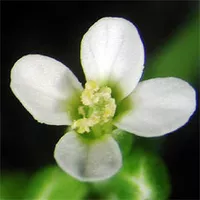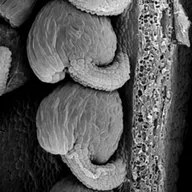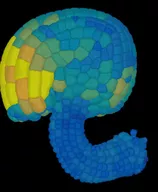Plant Developmental Biology
Welcome to the Professorship of Plant Developmental Biology at TUM! We are interested in the genetic, molecular, and cellular basis of the regulatory pathways controlling organ development and tissue morphogenesis.
The lab is located at the TUM School of Life Sciences. It is a member of the research unit "Computational morphodynamics of plants" (FOR 2581).
The Schneitz Lab - Shaping Beauty

The Schneitz lab addresses a fundamental biological question: how does morphogenesis translate genotype into form. Morphogenesis is of complex nature as it integrates multiple processes acting at different scales, ranging from the molecular control of gene expression to cellular coordination in a tissue. In plants, the semi-rigid and biochemically complex cell wall plays a central role in the regulation of cell and organ growth or various stress responses. For example, for a plant cell to grow the cell wall has to be modified to allow cell expansion, which is driven by turgor pressure generated inside the cell. The cell wall also glues together plant cells within a tissue. The physical connection of plant cells results in mechanical constraints and stresses. Resolving the resulting tissue conflicts by minimizing those mechanical stresses plays an important role in morphogenesis. We are interested in how the cell wall affects development and stress responses. To this end we conduct two strands of research.
Signal Transduction at the Plasma Membrane - Cell Wall Interface
What molecular framework regulates dynamic cell wall remodeling? Changes in cell wall architecture need to be monitored by individual cells and to be coordinated across cells in a growing tissue. Cell wall surveillance also comes into play in the reaction against certain stresses, including for example infection by plant pathogens, many of which break through the cell wall during infection, thereby generating wall-derived factors that can induce defense responses. In this context we focus on the function of the atypical receptor kinase STRUBBELIG (SUB) at the interface of growth control and the regulation of cell wall surveillance. Data from our and other labs had long indicated that SUB plays a central role in floral morphogenesis, ovule development and root hair patterning. In an important recent achievement we discovered that SUB is also a central component of the molecular framework that monitors cell wall integrity and that directs the stress response to altered cell wall biochemistry. Our present evidence indicates that SUB may exerts its various functions by partipating in different signaling complexes at the cell surface. We are currently identifying additional members of the SUB-containing signaling complexes involved in controlling cell wall integrity and remodelling and we are investigating the downstream signaling mechanisms.
Analysis of Ovule Curvature Using 3D Digital Ovules



How do cells coordinate their behavior during morphogenesis? How do mechanical forces influence tissue shape? To address these questions we study the formation of the three-dimensional architecture of the ovule, the central female reproductive organ of higher plants. In a major recent breakthrough we succeeded in generating 3D digital ovules with cellular resolution. Moreover, our reference atlas encompasses all developmental stages and includes annotation of the major tissues. This milestone was achieved in an extremly fruitful collaborative endeavour with computer scientists. The strategy involved a combination of advanced microscopy with 3D image processing guided by artificial intelligence. 3D digital ovules of wild-type or mutants not only enable quantitative spatio-temporal analysis of many cellular properties throughout the ovule but also the investigation of gene and protein expression patterns with cell and tissue resolution. Moreover, they provide computational modelling with realistic tissue templates. We now build on and extend those efforts by applying genetics, advanced imaging and mathematical modelling of growth. In an iterative approach between experiment and model-based predictions, we are investigating the cellular mechanism underlying integument growth and ovule curvature. This interdisciplinary approach will not only improve our understanding of ovule curvature but will also contribute to the general knowledge of how organs shape themselves into complex three-dimensional structures.
In the experimental work the lab focuses on the model plant Arabidopsis thaliana. As necessitated by the biological question the lab uses a broad range of different techniques, ranging from classical genetics and molecular biology to modern proteomic approaches, advanced imaging methodology (CLSM, FA, FRET-FLIM), and computational cell and developmental biology.
More information about the lab can be found on this website. If you are interested in a practical course, a BSc, MSc or PhD thesis, or if you are considering to join the lab as a postdoc please contact:
Prof. Dr. Kay Schneitz: kay.schneitz[at]tum.de.
The Torres Ruiz Lab - Embryo Development

The Torres Ruiz lab concentrates on the analysis of key genes of Arabidopsis thaliana involved in the elaboration of the apical region of the embryo, in particular on key genes of cotyledon development. Some of the analyzed genes also control specific processes of late plant development as well as the shape and size of the plant. More recently the lab has begun to carry out a genome- and transcriptome based project which aims to analyse polyploidy in Arabidopsis and other plants. This also includes the study of chromosome structure.
Financial Support
Our present research is funded by the German Research Foundation (DFG), the Free State of Bavaria, the Federal Ministry of Education and Research, and the TU Munich.






